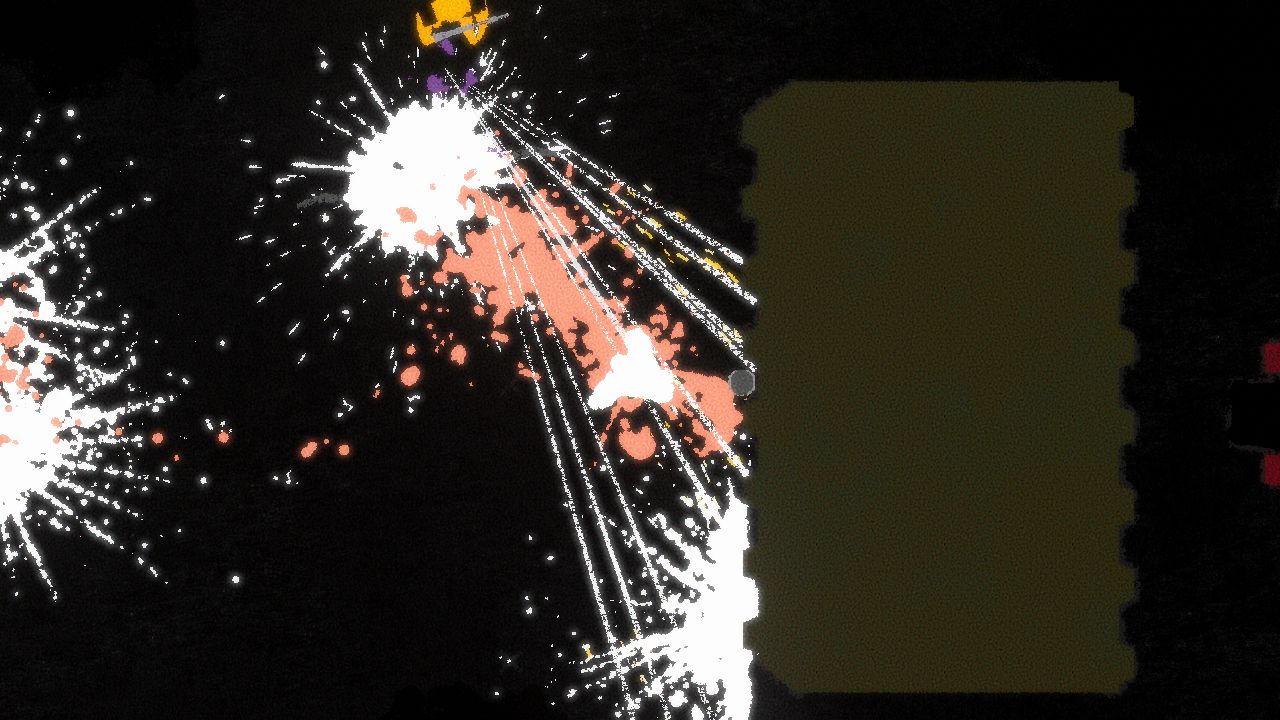How the frenetic jazz of Ape Out elevates its violence
Ape me out tonight
From the languid tempo that starts each level, to the frenetic bebop energy driving a series of devastating assaults, the soundscape of the indie beat ‘em up Ape Out is all about contrasts. As the eponymous gorilla, Ape Out lets players exact revenge against a battalion of doughy humans who are too feeble to stand directly against your wrath. It’s thunderous centrifuge of jazz and violence where the former is just as important as the latter.
“It's a game that goes between extremes,” says Matt Boch, an associate arts professor at the NYU Game Center and the composer and sound designer of Ape Out’s dizzying soundtrack. “We're trying to give people [the experience of having] these heights of intensity, and then the low points that build suspense.”
Together with Gabe Cuzzillo, the developer of Ape Out and an NYU graduate, Boch wanted to constantly keep players tense. One way is by creating procedurally generated levels, so new rampages don't become predictable. And accentuating this is the music. The game’s soundtrack thrives on tightly wound bursts of jazz drumming that evolve to the flow of players’ movement. Ape Out’s sonic cacophony sets the stage for an exhilarating performance.
On the face of it, there’s very little subtlety involved. You start every round by biding your time, eager for combat, as a soft beat drifts along behind you. Then you lunge towards your shadowy captors, pummeling away as splotches of blood and various debris paint the scene. A third, fourth, and fifth punch soon follows, and the soundtrack rises in intensity with your every move. On-screen you’re an enraged gorilla mowing through waves of enemies, but it somehow seems that the gorilla is also conducting and improvising the game’s soundtrack (presumably sending blood splatter over the walls with every flick of the baton).
Many soundscapes in games can be broadly categorised as procedurally generated. An easy example is how, in many games, the background track will switch to one that’s fraught with tension if your character is in danger (like the traumatic melody that plays whenever Sonic is drowning and only has a few precious seconds to find an air bubble). A more reactive system may take this further, with musical scores put together from different riffs that the system cobbles together, making various combinations of these parts depending on the circumstances the player is in.
Ape Out’s system is certainly procedural, drawing “thousands of performances”. Boch describes it as being hyper-reactive to player movement, making decisions on what to play within milliseconds. He achieved this by dissecting the drum kit into its disparate parts -- the cymbals, the snare drum, the hi-hat, and so on -- with each being ‘played’ separately by the game and put together according to player movement.
“That’s how we're making hundreds of decisions in the time that most games are making one or two, as we operate at a much faster timescale,” says Boch. Kill an enemy on the left side of the screen? The system hits the crash cymbal that emanates from the left speaker. Attack a stray enemy on the upper right side of the screen? It reaches for a ride cymbal that will ring out at that spot, too. Eviscerate a small army of soldiers in rapid succession? Then it plays a frenzied beat, the system becoming a drummer slamming all their pedals and viciously beasting the whole kit with the sticks. Here’s a tip: you should probably play with top-of-the-range surround sound, or failing that, with headphones.
It’s akin to a live drummer altering their playing according to how the band is performing, as well as the mood they’re trying to conjure from moment to moment. Boch says that he and Cuzzillo like to think that the music system they've made is watching you play, and trying to react to you.
“One idea is that you get into encounters and you're trying to own all these various enemies," he says. "The system notices, and it will perform more intensely, hits the drums harder, and play more frenetic rhythms. And then when you defeat your last enemy, things calm down and the systems changes its fill to a different one.”
This ebb and flow is the basis of both the violent man-smashing and the score, and with the music system so attuned to whatever the player is doing it makes every pounce, jab, and kill in the game feel particularly satisfying.
But why drums, in particular? They fit for a couple of reasons. One is the inherently primal quality of the drums over instruments: the pounding, the bashing, the sheer racket. The physicality and stamina that drums demand carry parallels to the frenetic violence of being the ape in Ape Out. As he crafted the music, Boch captured details that gives the music something approaching a physical presence. In quieter moments before levels you can hear the sounds of a drummer setting up their kit, as they would before a gig, or the tossing and tapping of drum sticks against each other as the player tries to keep time. It adds to the an almost immersive feel to the game, where the player themselves is a musician -- part of an expert improv band.
As a percussive instrument, the drums also lend more impact to the game’s microsecond decisions, such as which part of the instrument to hit, and when.
“There’s a lot more opportunities to make those kind of decisions [with drums],” says Boch. “When you’re drumming, it’s more intense, and that allows for a lot of transitions and turn on a dime moments, whereas a more musical instrument doesn’t have the same payoff, and may sound a bit odd.”
He gives an example of sustaining a note on a trumpet; increasing the volume of the same note during an intense scene would take the player out of the moment, since it can feel too abrupt. This isn’t an issue with using drums, since every strike is an individual note.
Ape Out is also divided into four broad chapters (or records, if you will), each with their own quality, he says.
“We tried to explore a huge variety of percussion in order to keep things varied and interesting across each of those albums. Each has its own unique feel from an audio standpoint, but also from a gameplay standpoint. It’s a little like having four different versions of Ape Out.”
He described the first chapter as being the most quintessentially jazz. In contrast, the second record features more rudimentary percussion, inspired by the bucket drumming of buskers on the subway and city sidewalks. This chapter takes place in an office building, so the sound really drives home the chapter’s urban, metropolis vibe.
Boch is still thinking about prodding at and refining this music system, and says that there are still a lot of ideas he wants to explore. He’s keen to see how much more audacious the soundscape can be, and the role sound design can play in other games. Tellingly, he has a clear pedigree in music games, having worked at Harmonix for many years; he helped develop the plastic Rockband instruments, he directed the Dance Central games up to Dance Central 3, and was creative director on Fantasia: Music Evolved. But he feels that music in that genre played a vastly different role to the one it does in Ape Out.
“Music games don't have the same improvisational feel. They aren't about moving a character around the screen, or interacting with highly action-oriented moments,” says Boch.
Music games draw your attention through the music itself, in other words. Meanwhile, Boch describes Ape Out as having a different relationship to music due to its “music-centric gameplay” in which the music is inspired by the way you play the game. The music pays attention to you, not the other way around. An admirable work from someone who says he is more into music than programming.
“I didn't really start this with a great grasp of coding for games," he says. "Fast forward four years later, and I’m writing custom neural networks to grab and build new drum loops and whatever else. It's been a very intense period in terms of learning and skills acquisition, and taking a lot of this musical and audio knowledge that I've built up over my life and applying it in this newer context of games programming.”
Perhaps it’s through Ape Out that he was able to craft his most expansive musical opus yet: a brawler capable of improvising complex jazz melodies on the fly.













